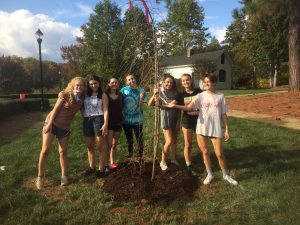By Annika Patterson
As Furman students, one of the many advantages of our gorgeous campus are the thriving populations of animals that cohabit with us. Whether in reference to the ducks and fish in the lake, the squirrels and birds in the trees and the hundreds of insects that illicit a variety of reactions, all of these lives are so precious and each gives back to our ecosystem in ways we seldom acknowledge.
Biodiversity is a topic that is close to my own heart as I have always loved and cared for animals. In the courses I have taken at Furman I have had the opportunity to learn even more about the terrible ways climate change has already, and will continue to affect our earth’s biodiversity. The Planetary boundaries, a term familiar to any fellow students of sustainability classes here at Furman, are a scientific-based framework for the analysis of the risk that humans are contributing to at which some point will destabilize the entirety of the earth system. Basically, a measurable scale in which we can determine the long term effects humans production and consumption are having on different systems of the earth, and boundaries in which we have established to try and avoid crossing to avoid this. As we are standing currently on this scale, globally we have more than crossed the planetary boundary for biodiversity loss. The boundary was set at less than 10 extinctions per million species year and in the holocene alone we can track a loss of 10-100 extinctions per million species year, a loss that resembles mass extinctions in millennia past.
The planetary boundaries are all connected in balancing each other out and further pushing each other towards a tipping point. This is shown in how species richness, a measurable subsection of biodiversity that is simply the number of different species, is important for the maintenance of the biosphere. The diversity of a number of species helps balance out ecosystems and provides a necessary resilience.
An example of nature and how it usually balances itself, and our reliance on such, is the disaster that is the Furman lake. A man made lake from the foundation of this location back in the 80s, it has been slowly deteriorating ever since. Constant projects over the years have aimed to restore the lake to a less sediment filled pool for disease has thus far been unachievable. The Furman lake is small in comparison to the majority of lakes i’ve visited in my life, and those naturally made lakes (whether or not a dam has been added) have been majorly self sustaining in the bacterial level up to the birds that fish there. This is no coincidence, nature is a self sustaining system and left alone it has the opportunity to flourish.
While leaving our communities wildlife alone isn’t an easy feat in a city like Greenville, programs for conservation and clean up are important for taking back the blows humanity has made against them. It is important as an individual to make large scale change in advocating for and voting in favor of programs that will preserve our local biodiversity and on a small scale doing what you can in your own neighborhood. Protecting the environment of a single animal can have impacts on the ecosystem we can’t predict, so do your part!
Sources
-https://greenvillejournal.com/op-ed/letter-to-the-editor-we-must-preserve-biodiversity/
-https://awsassets.panda.org/downloads/lpr_living_planet_report_2016.pdf
-https://www.khanacademy.org/partner-content/cas-biodiversity/why-is-biodiversity-important-ca/biodiversity-and-ecosystem-funct/v/biodiversity-ecosystems-and-ecological-networks?modal=1


